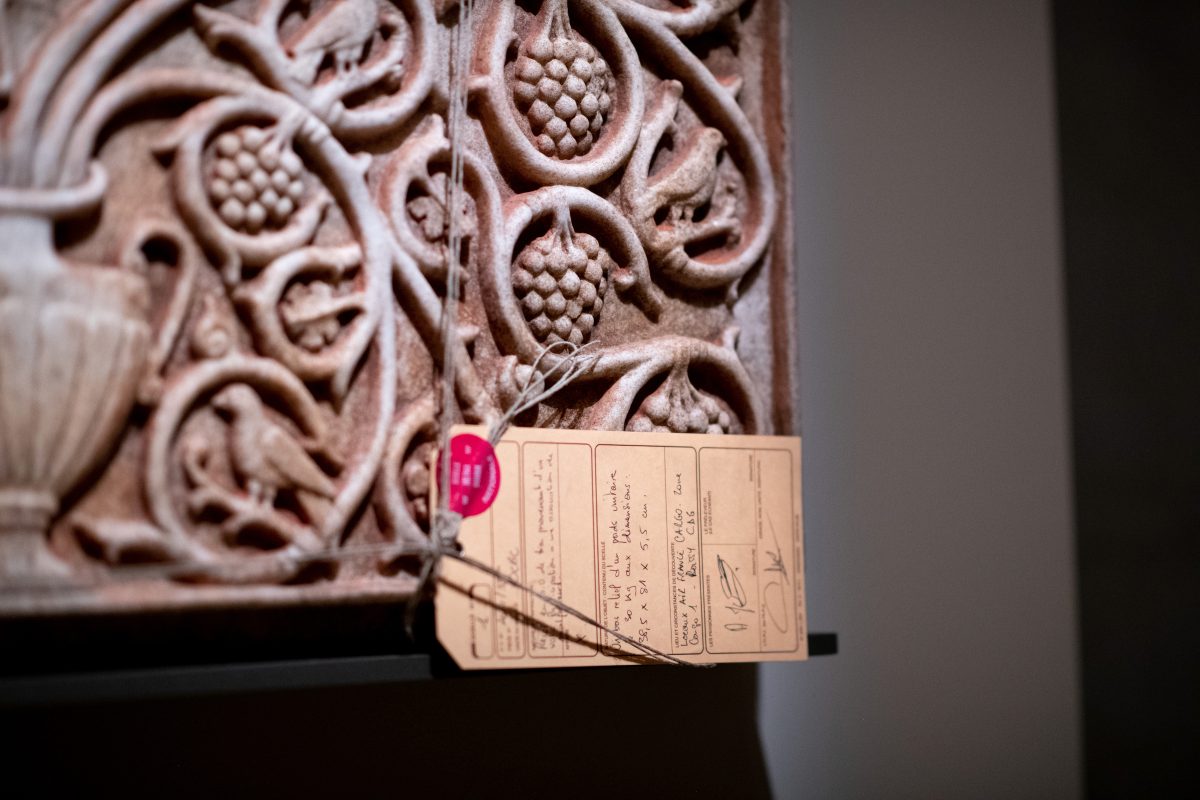
It’s a dignified, austere pose befitting the incarnated goddess of death. She stands, along with the fragments of three inanimate companions, showing the wear and tear of centuries in the heart of Paris — far away from her native Mediterranean coastline and the deceased she’s supposed to protect.
Between 2012 and 2016, French customs discovered and identified six artifacts presumed to have been trafficked from war-affected Libya and Syria. These include funerary statues from the Libyan region of Cyrene and Byzantine-era reliefs likely from Palmyra. The Louvre Museum, which recently reopened after the country’s latest pandemic lockdown, temporarily exhibits them under seal in its famed Denon aisle through December 2021. The museum views their presence as a testament, a contribution to increased public awareness on the issue of looting — except it forgets that it is already a violent graveyard of colonial-era cultural trophies removed from their homelands under dubious circumstances.
About 20 years into the catastrophic United States-led “wars on terror” and a decade into the revolutions which instigated hope for systemic change throughout the Arab world before facing a debilitating hangover, the exhibition curators recall the platitude that heritage sites within warzones across North Africa and West Asia are in grave danger. In the case of Cyrene, a passive-voiced statement attributes this circumstance to “an unbridled urbanization which accelerated since the Arab Spring,” together with “opportunistic amateurs and criminal networks prospering in the wake of the crisis” affecting Libya. Whose crisis, and most crucially, whose responsibility?
In 2011, I lived in Beirut, Lebanon. I worked there for the United Nations and I recall young people protesting across the region, aspiring to basic — so called universal — human rights, which is to say they demanded to be able to lead a decent life free from want and fear. They prominently marched in Tunisia, where half of my family comes from, and of course in Syria and other places.
Are these young people, arguably the first victims of the disenchantment brought on by the unfolding proxy wars, to be blamed for plundering their own culture as the Louvre curators seemingly imply? What if the protests never happened, would all be fine for heritage sites? Narratives matter and a closer inspection should be paid instead to France’s very active role in these conflicts, and the decades of Western connivance in sustaining corrupt “ally” regimes until this exposure was no longer defensible. We should also examine how economic interests have benefited from morally compromised, lucrative opportunities which fuel complex war economies now exacerbated by COVID-19.
In an interview, Ludovic Laugier, one of the co-curators, states that it’s better for these fine-looking items to be admired in the Louvre rather than in the confines of a police station or court vault. This is quite a touching, romantic consideration for the public and the ideals of beauty, though perhaps videos or photos would have sufficed rather than organizing a media fanfare which incidentally brings additional revenue flow to the museum itself. How much of this revenue is going to the families of Libyans and Syrians who continue to perish at sea and on land?

“There is blood on these artifacts,” Laugier continues, likely unaware of the irony, if not dissonance, of this situation. If the Louvre museum is genuine about combatting the wrongful acquisition of artwork, which I would fully commend, it should start with decolonizing its century-long institutional practice and accelerate voluntary restitutions. While museum collections are considered inalienable, theft should void such policies, and justice starts at home.
Since 2016, it’s been permissible under French law to showcase trafficked art pieces under investigation (if a judge agrees to it) and the Louvre is the first museum in the country to do so. It’s not an illegal undertaking per se. As a dual Tunisian-French citizen, I’m grateful that French public entities acknowledge the sophistication of the ancient Mediterranean civilization, a shared legacy of syncretic beliefs, and mutually-enriching exchanges and migration, even if these artifacts are narrowly (subconsciously?) hosted in the Greek Antiquities department. I regret, however, that the same effort isn’t always exerted towards the people living or originating from these spaces who are worthy of no less protection than statues. One could for example, refrain from enforcing harmful policies against asylum seekers.
While a long-awaited and broader reckoning slowly permeates the French art scene, the outcome of ongoing investigations will decide when to return the trafficked pieces to Libya and Syria (at this point, possibly in 2022). To me, these six artifacts represent the haunting ghosts of a French failure to question incisively, to act expeditiously, and to care a little bit more.
0 Commentaires